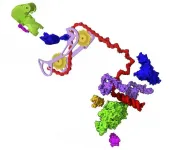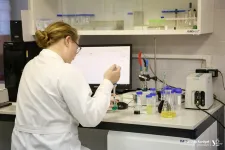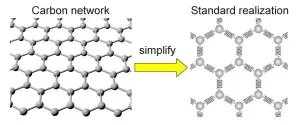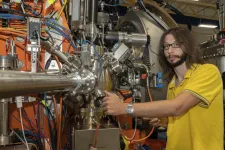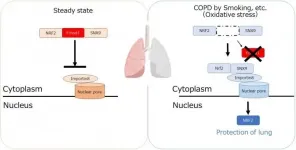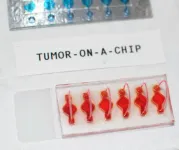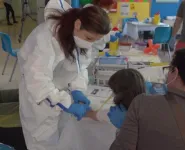(Press-News.org) In February 2020, a trio of bio-imaging experts were sitting amiably around a dinner table at a scientific conference in Washington, D.C., when the conversation shifted to what was then a worrying viral epidemic in China. Without foreseeing the global disaster to come, they wondered aloud how they might contribute.
Nearly a year and a half later, those three scientists and their many collaborators across three national laboratories have published a comprehensive study in Biophysical Journal that - alongside other recent, complementary studies of coronavirus proteins and genetics - represents the first step toward developing treatments for that viral infection, now seared into the global consciousness as COVID-19.
Their foundational work focused on the protein-based machine that enables the SARS-CoV-2 virus to hijack our own cells' molecular machinery in order to replicate inside our bodies.
From structure to function to solutions
"It has been remarked that all organisms are just a means for DNA to make copies of itself, and nowhere is this truer than in the case of a virus," said Greg Hura, a staff scientist at Lawrence Berkeley National Laboratory (Berkeley Lab) and one of the study's lead authors. "A virus's singular task is to make copies of its genetic material - unfortunately, at our expense."
Viruses and mammals, including humans, have been stuck in this battle for millions of years, he added, and over that time the viruses have evolved many tricks to get their genes copied inside us, while our bodies have evolved counter defenses. And although viruses often perform a long list of other activities, their ability to harm us with an infection really does come down to whether or not they can replicate their genetic material (either RNA or DNA, depending on the species) to make more viral particles, and use our cells to translate their genetic code into proteins.
The protein-based machine responsible for RNA replication and translation in coronaviruses - and many other viruses - is called the RNA transcription complex (RTC), and it is a truly formidable piece of biological weaponry.
To successfully duplicate viral RNA for new virus particles and produce the new particles' many proteins, the RTC must: distinguish between viral and host RNA, recognize and pair RNA bases instead of highly similar DNA bases that are also abundant in human cells, convert their RNA into mRNA (to dupe human ribosomes into translating viral proteins), interface with copy error-checking molecules, and transcribe specific sections of viral RNA to amplify certain proteins over others depending on need - while at all times trying to evade the host immune system that will recognize it as a foreign protein.
As astounding as this sounds, any newly evolved virus that is successful "must have machines that are incredibly sophisticated to overcome mechanisms we have evolved," explained Hura, who heads the Structural Biology department in Berkeley Lab's Molecular Biophysics and Integrated Bioimaging Division.
He and the other study leads - Andrzej Joachimiak of Argonne National Laboratory and Hugh M. O'Neill at Oak Ridge National Laboratory - specialize in revealing the atomic structure of proteins in order to understand how they work at the molecular level. So, the trio knew from the moment they first discussed COVID-19 at the dinner table that studying the RTC would be particularly challenging because multitasking protein machines like the RTC aren't static or rigid, as molecular diagrams or ball-and-stick models might suggest. They're flexible and have associated molecules, called nonstructural and accessory proteins (Nsps), that exist in a multitude of rapidly rearranging forms depending on the task at hand - akin to how a gear shifter on a bike quickly adapts the vehicle to changing terrain.
Each of these Nsp arrangements give insights into the protein's different activities, and they also expose different parts of the overall RTC surface, which can be examined to find places where potential drug molecules could bind and inhibit the entire machine.
So, following their serendipitous convergence in Washington, the trio hatched a plan to pool their knowledge and national lab resources in order to document the structure of as many RTC arrangements as possible, and identify how these forms interact with other viral and human molecules.
Science during shutdowns
The investigation hinged on combining data collected from many advanced imaging techniques, as no approach by itself can generate complete, atomic-level blueprints of infectious proteins in their natural states. They combined small-angle X-ray scattering (SAXS), X-ray crystallography, and small-angle neutron scattering (SANS) performed at Berkeley Lab's Advanced Light Source, Argonne's Advanced Photon Source, and Oak Ridge's High Flux Isotope Reactor and Spallation Neutron Source, respectively, on samples of biosynthetically produced RTC.
Despite the extraordinary hurdles of conducting science during shelter-in-place conditions, the collaboration was able to work continuously for more than 15 months, thanks to funding for research and facility operations support from the Department of Energy's Office of Science National Virtual Biotechnology Laboratory (NVBL). During that time, the scientists collected detailed data on the RTC's key accessory proteins and their interactions with RNA. All of their findings were uploaded into the open-access Protein Data Bank prior to the journal article's publication.
Of the many structural findings that will help with drug design, one notable discovery is that assembly of the RTC subunits is incredibly precise. Drawing on a mechanical metaphor once more, the scientists compare the assembly process to putting together a spring-based machine. You can't put a spring in place when the rest of the machine is already in position, you must compress and place the spring at a specific step of assembly or the whole device is dysfunctional. Similarly, the RTC Nsps can't move into place in any random or chaotic order; they must follow a specific order of operations.
They also identified how one of the Nsps specifically recognizes the RNA molecules it acts upon, and how it cuts long strands of copied RNA into their correct lengths.
"Having the vaccines is certainly huge. However, why are we satisfied with just this one avenue of defense?" said Hura. Added Joachimiak: "This was a survey study, and it has identified many directions we and others should pursue very deeply; to tackle this virus we will need multiple ways of blocking its proliferation."
"Combining information from different structural techniques and computation will be key to achieving this goal," said O'Neill.
Due to the similarity of RTC proteins across viral strains, the team believe that any drugs developed to block RTC activity could work for multiple viral infections in addition to all COVID-19 variants.
Reflecting back to the beginning of their research journey, the scientists marvel at the lucky timing of it all. When we started to talk, said Hura, "we had no idea that this epidemic would soon become a pandemic that would change a generation."
INFORMATION:
This study was supported by the DOE Office of Science through the NVBL, a consortium of DOE national laboratories focused on the response to COVID-19, with funding provided by the Coronavirus CARES Act; and by the National Institutes of Health. The Advanced Light Source, Advanced Photon Source, High Flux Isotope Reactor, and Spallation Neutron Source are DOE Office of Science user facilities.
Russian scientists have synthesized chemical compounds that can stop the degeneration of neurons in Alzheimer's, Parkinson's, and other severe brain pathologies. These substances can provide a breakthrough in the treatment of neurodegenerative pathologies. New molecules of pyrrolyl- and indolylazine classes activate intracellular mechanisms to combat one of the main causes of "aged" brain diseases - an excess of so-called amyloid structures that accumulate in the human brain with age. The essence of the study was published in the European Journal of Medicinal Chemistry. Experts from the Institute of Cytology of the Russian Academy of Sciences, the Institute of Organic Synthesis of the Ural Branch of the Russian ...
A new mathematical model helps predict the tiny changes in carbon-based materials that could yield interesting properties.
Scientists at Tohoku University and colleagues in Japan have developed a mathematical model that abstracts the key effects of changes to the geometries of carbon material and predicts its unique properties.
The details were published in the journal Carbon.
Scientists generally use mathematical models to predict the properties that might emerge when a material is changed in certain ways. Changing the geometry of three-dimensional (3D) graphene, which is made of networks of carbon atoms, by adding chemicals or introducing topological defects, can improve its catalytic properties, for example. But it has been difficult for scientists to understand why this happens exactly.
The ...
Researchers from the Paul Scherrer Institute PSI and the Brookhaven National Laboratory (BNL), working in an international team, have developed a new method for complex X-ray studies that will aid in better understanding so-called correlated metals. These materials could prove useful for practical applications in areas such as superconductivity, data processing, and quantum computers. Today the researchers present their work in the journal Physical Review X.
In substances such as silicon or aluminium, the mutual repulsion of electrons hardly affects the material properties. Not so with so-called correlated materials, in which the electrons interact strongly with one another. The movement of one electron in a correlated material leads ...
Prof. LI Chuanfeng, Prof. XU Jinshi and their colleagues from Prof. GUO Guangcan's group, University of Science and Technology of China (USTC) of the Chinese Academy of Sciences (CAS), realized the high-contrast readout and coherent manipulation of a single silicon carbide divacancy color center electron spin at room temperature for the first time in the world, in cooperation with Prof. Adam Gali, from the Wigner Research Centre for Physics in Hungary. This work was published in National Science Review on July 5, 2021.
Solid-state spin color centers are of utmost importance in many applications of quantum technologies, the outstanding one among which is the nitrogen-vacancy (NV) center in diamond. Since the detection ...
African swine fever (ASF), first detected in Germany in domestic pigs on 15 July 2021, does not pose a health hazard to humans. "The ASF pathogen cannot be transferred to humans", explains Professor Dr. Dr. Andreas Hensel, President of the German Federal Institute for Risk Assessment (BfR). "No risk to health is posed by direct contact with diseased animals or from eating food made from infected domestic pigs or wild boar".
The ASF pathogen is a virus which infects domestic pigs and wild boar and which leads to a severe, often lethal, disease in these animals. It is transferred via direct contact or with excretions from infected animals, or through ticks. The ASF virus is endemic to infected wild animals ...
Tokyo, Japan - Chronic obstructive pulmonary disease (COPD) causes illness and death worldwide. It is characterized by destruction of the walls of tiny air sacs in the lungs, known as emphysema, and a decline in lung function. Little has been known about the mechanisms by which it begins to develop. But now, researchers from Japan have found a protein that promotes the development of the early stages of emphysema, with the potential to be a therapeutic target.
COPD can be triggered by environmental factors such as cigarette smoking that result in lung inflammation. The development of inflammation involves the movement ...
WINSTON-SALEM, NC, JULY 19, 2021 -- Wake Forest researchers and clinicians are using patient-specific tumor 'organoid' models as a preclinical companion platform to better evaluate immunotherapy treatment for appendiceal cancer, one of the rarest cancers affecting only 1 in 100,000 people. Immunotherapies, also known as biologic therapies, activate the body's own immune system to control, and eliminate cancer.
Appendiceal cancer is historically resistant to systemic chemotherapy, and the effect of immunotherapy is essentially unknown because clinical trials are difficult to perform due to lack of ...
COLUMBUS, Ohio - When COVID-19 hit, affluent Columbus residents responded by taking significantly fewer trips to large grocery and big-box stores, apparently ordering more online and stocking up when they did go out to shop.
With fewer options available to them, low-income people had to double down on what they had always done: regular trips to the local dollar stores and small groceries to get their family's food.
That's the conclusion of a new study that analyzed traffic to Columbus grocery sellers before, during and after the COVID-19 lockdown.
Dollar stores and small local grocers in neighborhoods housing mostly low-income people of color didn't see as much of a decline in customers during the lockdown as did large grocery and big-box stores, ...
Tokyo, Japan - Designing materials that have the necessary properties to fulfill specific functions is a challenge faced by researchers working in areas from catalysis to solar cells. To speed up development processes, modeling approaches can be used to predict information to guide refinements. Researchers from The University of Tokyo Institute of Industrial Science have developed a machine learning model to determine characteristics of bonded and adsorbed materials based on parameters of the individual components. Their findings are published in Applied Physics Express.
Factors such as the length and strength of bonds in materials play ...
Testing of an entire Italian town shows antibody levels remain high nine months after SARS-CoV-2 infection, whether symptomatic or asymptomatic.
Researchers from the University of Padua and Imperial College London tested more than 85 percent of the 3,000 residents of Vo', Italy, in February/March 2020 for infection with SARS-CoV-2, the virus that causes COVID-19, and tested them again in May and November 2020 for antibodies against the virus.
The team found that 98.8 percent of people infected in February/March showed detectable levels of antibodies in November, and there was no difference between people who had suffered symptoms of COVID-19 and those that had been symptom-free. The results are ...
